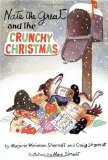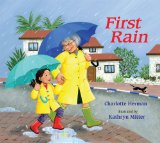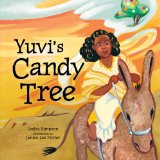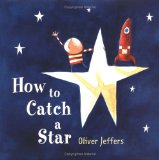I’m thinking a lot about Christmas these days. There are beautiful lights everywhere, friends have their trees up and it has been a long, long time since Hanukkah for my kids. They haven’t said anything yet, but I’m waiting…
So my first thought is to turn to books. I’m looking for books for children that feature Jews being Jewish at Christmas time — and preferably not Jews doing Hanukkah while others do Christmas since that’s not the case this year. Here’s my top choices:
 The Trees of the Dancing Goats by Patricia Polacco. This kind of breaks the rule of not including books about Hanukkah, but I’d argue that the book really isn’t about Hanukkah at all. Here’s the book description:
The Trees of the Dancing Goats by Patricia Polacco. This kind of breaks the rule of not including books about Hanukkah, but I’d argue that the book really isn’t about Hanukkah at all. Here’s the book description:
Trisha loves the eight days of Hanukkah, when her mother stays home from work, her Babushka makes delicious potato latkes, and her Grampa carves wonderful animals out of wood as gifts for Trisha and her brother. In the middle of her family’s preparation for the festival of lights, Trisha visits her closest neighbors, expecting to find them decorating their house for Christmas. Instead they are all bedridden with scarlet fever. Trisha’s family is one of the few who has been spared from the epidemic. It is difficult for them to enjoy their Hanukkah feast when they know that their neighbors won’t be able to celebrate their holiday. Then Grampa has an inspiration: they will cut down trees, decorate them, and secretly deliver them to the neighbors, “But what can we decorate them with?” Babushka asks. Although it is a sacrifice, Trisha realizes that Grampa’s carved animals are the perfect answer. Soon her living room is filled with trees — but that is only the first miracle of many during an incredible holiday season.
What I really like about this book is that it is absent the longing of Christmas and really features two people living side by side, practicing their own religions, and helping each other when they need it.

Elijah’s Angel by Michael Rosen. Again, this does have Hanukkah, probably more importantly placed than the Polacco suggestion, but I really like it. The Amazon review:
A child’s vision of religious tolerance is exquisitely played out in this story about an elderly Christian barber and a Jewish child who befriends him. As a hobby, the African American barber makes elaborate woodcarvings–many of which refer to events or characters in the Bible. Michael, a 9-year-old Jewish boy, often visits the barbershop just to admire old Elijah’s carvings, especially that of Noah’s Ark–a story that belongs to Jewish as well as Christian teachings. One day when Hanukkah and Christmas coincidentally overlap, Elijah gives Michael a special gift, a carved guardian angel. Immediately Michael is filled with a jumble of feelings–gratitude for such a beautiful gift, concern that his parents might disapprove, and an even greater fear that God may frown upon a Christmas angel, “a graven image,” in Michael’s home. The thick sweeps of paint, the heavy uses of wood-tones, and primitive images make the settings and characters look as though Elijah carved them himself. When Michael finally reveals the carved angel to his parents, they help the young boy understand how expressions of friendship, love, and protection can be carried into any home, regardless of the household’s religion.
Again, lovely story about friendship and people being happy with who they are.

Another new book out this season is the gorgeous A Chanukah Noel by Sharon Jennings. This one takes the very realistic plot of a Jewish child who wants to celebrate Christmas. The Booklist review:
Based on a true incident, this historical picture book is about Charlotte, who has moved to a small town in France. Charlotte feels left out, especially at Christmastime, not only because she’s American but also because she’s Jewish. At least Charlotte can participate in the school holiday activities, but during the grab-bag pull, she realizes that classmate Colette Levert is too poor to purchase a present for the exchange. This gives Charlotte an idea. Perhaps she can bring Christmas to Colette’s family. On Christmas Eve, Charlotte’s family carries a Christmas tree, decorations, food, and gifts to the Leverts. In return, the Leverts ask Charlotte’s family to stay and share their holiday feast and “the joy of Christmas and Chanukah.”
And, since we have a good number of Jews help save Christmas stories, here’s a corollary. The Christmas Menorahs: How a Town Fought Hate by Janice Cohn. The Boolist review:
Based on a true incident that occurred in Billings, Montana, this story begins when a rock is thrown through a boy’s bedroom window in which a menorah is displayed. The boy, Isaac, is frightened and unsure whether he wants to put the menorah back. His parents call the police, and his mother goes on television and to a meeting to talk about hate crimes in the community. Inspired by stories of the Danish people helping their Jewish neighbors during World War II, the people of Billings put menorahs in their windows to take a stand against bigotry. When a schoolmate supports Isaac, he takes his own stand by returning the menorah to its place. Although the plot seems a little stilted at times, Cohn deals with the issues in a way children can readily understand.

Finally, a book that I’m not sure how to categorize, except to say that it’s a weeper. The Christmas Tapestry by Patricia Polacco is not about Hanukkah or being Jewish at all. It’s really just a Christmas story, but with a really interesting Jewish link. From Booklist:
Polacco is a master at intergenerational, interfaith stories that bring comfort and joy, and this one based on homilies she had heard widely separated in time and place is no exception. Jonathan must adjust when his preacher father moves the family to Detroit. After lots of work, the church is almost ready for Christmas, but then ice damage gouges a hole in a church wall. Father and son find a beautifully embroidered hanging and buy it with the last of their money; as they wait in the snow for the bus, an old woman offers them tea from her thermos. When they finally get to the parsonage, she is astonished to find the tapestry is one she had made as a chuppah for her wedding in Germany, before she was separated from her new husband who was lost in the war. The plasterer, who comes to fix the hole, also recognizes the hanging, and delighted audiences will soon figure out his identity. Christian and Jewish holiday celebrations intermingle with the message that nothing in the universe is random. The tender colors and gestures in the illustrations echo the text to make a satisfying whole.
The story is beautiful and touching and likely missed by many Jews because of the overt Christmas message of the description. It’s really quite incredible.
 And a bonus. If your kids really want the Christmas book, offer them Nate the Great and the Crunchy Christmas by Marjorie Wienman Shermat. Tuns out that everyone’s favorite mystery solving little boy doesn’t celebrate Christmas either. It’s a great surprise for kids, and a wonderful “aha” moment. Jewish characters aren’t just in Jewish books. Sometimes they turn up in the least likely place…
And a bonus. If your kids really want the Christmas book, offer them Nate the Great and the Crunchy Christmas by Marjorie Wienman Shermat. Tuns out that everyone’s favorite mystery solving little boy doesn’t celebrate Christmas either. It’s a great surprise for kids, and a wonderful “aha” moment. Jewish characters aren’t just in Jewish books. Sometimes they turn up in the least likely place…
Last thought: Lisa Silverman, a fantastic Jewish librarian and connoisseur of Jewish children’s book writes about A Chanukkah Noel and a new book (that I haven’t seen so didn’t include in this round up because I haven’t read it) called Jackie’s Gift: A True Story of Christmas, Hanukkah, and Jackie Robinson, written by Jackie’s daughter, Sharon Robinson. While I disagree with her Hanukkah book suggestions, I think the article itself is great.
 Another wonderful new rerelease is Purim Play by Roni Schotter (with the fantastic “old” illustrations of Marylin Hafner). Purim Play is the story of Frannie and the Purim play that she is trying to create with her brother and cousins. When her cousins fall in and can’t come, Frannie all but gives up on the play. Until, reluctantly, she accepts the help of her neighbor Mrs. Teplitzky, who proves to be a formidable Haman and a wonderful teacher. In addition to be a being a great story, I love that this is Judaism celebrated in the home, and most of all that it comes with a great script for creating a Purim Play. Great for children 7-11 years old.
Another wonderful new rerelease is Purim Play by Roni Schotter (with the fantastic “old” illustrations of Marylin Hafner). Purim Play is the story of Frannie and the Purim play that she is trying to create with her brother and cousins. When her cousins fall in and can’t come, Frannie all but gives up on the play. Until, reluctantly, she accepts the help of her neighbor Mrs. Teplitzky, who proves to be a formidable Haman and a wonderful teacher. In addition to be a being a great story, I love that this is Judaism celebrated in the home, and most of all that it comes with a great script for creating a Purim Play. Great for children 7-11 years old. This year also marks the release of two new retellings of the Purim story. Eric Kimmel’s The Story of Esther: A Purim Tale is a faithful and attractive retelling of the Purim story. It’s not the preschool version of the story (where Haman just wants the Jews to leave) but it’s a great version for children 6 and up. Tilda Balsley’s The Queen Who Saved Her People also sticks pretty close to the “real story” but because it’s presented as a reader’s theatre play (much like her Exodus story, Let My People Go), it reads slightly more comically and irreverently. Also good for children 6 and up and lovely for creating theater at home, at school or anywhere.
This year also marks the release of two new retellings of the Purim story. Eric Kimmel’s The Story of Esther: A Purim Tale is a faithful and attractive retelling of the Purim story. It’s not the preschool version of the story (where Haman just wants the Jews to leave) but it’s a great version for children 6 and up. Tilda Balsley’s The Queen Who Saved Her People also sticks pretty close to the “real story” but because it’s presented as a reader’s theatre play (much like her Exodus story, Let My People Go), it reads slightly more comically and irreverently. Also good for children 6 and up and lovely for creating theater at home, at school or anywhere.
 Rita Golden Gelman’s Queen Esther Saves Her People is also a lovely retelling, with fairytale aspects that is sure to resonate for children who like those types of books (are there children who don’t?).
Rita Golden Gelman’s Queen Esther Saves Her People is also a lovely retelling, with fairytale aspects that is sure to resonate for children who like those types of books (are there children who don’t?).



 The Trees of the Dancing Goats
The Trees of the Dancing Goats











 When Jessie Came Across the Sea
When Jessie Came Across the Sea


















